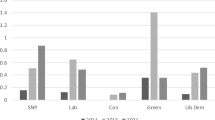Abstract
The aim of this chapter is to analyse the strategies of the political parties when facing women as potential candidates, arguing that the resistance to women as representatives was fiercer than to women as voters. The analytical focus lies on the nomination and electoral processes in the first parliamentary elections with next to universal suffrage in Denmark (1918) and Sweden (1921), using a combination of unpublished party protocols, newspapers, and contemporary electoral statistics. The findings show that the poor result for women—3% women to the Danish Lower Chamber (Folketinget) and 1.7% women to the Swedish Lower Chamber (Riksdagens andra kammare)—was not primarily due to the voters, but to the political parties, who, supported by the closed electoral ballot structure, were the gatekeepers to elected positions. The major factor explaining this poor outcome was the prerogative of the incumbents, e.g. those MPs (evidently, at this time all males), who had won their seats in previous elections and wanted to stand for re-election.
Access this chapter
Tax calculation will be finalised at checkout
Purchases are for personal use only
Similar content being viewed by others
References
Arvidsson, M. (2021). Att tala till kvinnor och vinna deras röster. Socialdemokratiska kvinnoförbundets agitation inför valet 1921. Historisk Tidskrift, 141(3):443–475.
Bergqvist, C. et al. (Eds.). (1999). Equal Democracies? Gender and Politics in the Nordic Countries. Oslo: Scandinavian University Press.
Björk, G. (1999). Att förhandla sitt medborgarskap – kvinnor som kollektiva politiska aktörer i Örebro 1900–1950. Lund: Arkiv (diss.).
Cowell-Meyers, K., Evans, E. and Ki-young Shin, S. (2020). Women’s Parties: A New Party Family. Politics & Gender, 16(1):4–25.
Dahlerup, D. (1978). Women’s Entry into Politics: The Experience of the Danish Local and General Elections 1908–20. Scandinavian Political Studies, 1(2–3):139–162.
Dahlerup, D. (1979). Kvinders organisering i det danske Socialdemokrati 1908–69. Meddelelser om Forskning i Arbejderbevægelsens Historie, 13(5):5–35.
Dahlerup, D. (2015). “Blev valgretten et gennembrud for kvinder i dansk politik?” In A. Borchorst and D. Dahlerup, Før og efter stemmeretten. Køn, demokrati og velfærd (pp. 105–126). Copenhagen: Frydenlund Academics.
Dahlerup, D. (2018). Has Democracy Failed Women? Cambridge: Polity Press.
Dahlerup, D. and Freidenvall, L. (2005). Quotas as a Fast Track to Equal Representation for Women. Why Scandinavian Is No Longer the Model. International Feminist Journal of Politics, 7(1):26–48.
Dahlerup, D. and Freidenvall, L. (2018). “Vägen till varannan damernas. Gríndvakter, kvotering och representation.” In U. Holgersson and L. Wängnerud (Eds.), Rösträttens århundrade (pp. 305–325). Stockholm: Makadam Förlag.
Dahlerup, D. and Leyenaar, M. (Eds.). (2013). Breaking Male Dominance in Old Democracies. Oxford: Oxford University Press.
Esaiasson, P. (1990). Svenska valkampanjer 1866–1988. Stockholm: Allmänna Förlaget.
Flood, H. (1954). Agda Östlund: pionjär i genombrottstid. Stockholm: Kooperativa förbundets bokförlag.
Florin, C. (2006). Kvinnor får röst: Kön, känslor och politisk kultur i kvinnornas rösträttsrörelse. Stockholm: Atlas Akademi.
Freidenvall, L. (2021). Equal Participation Without Legislation. Rowman & Littlefield.
Freidenvall, L. et al. (2006). “The Nordic Countries: An Incremental Model.” In D. Dahlerup (Ed.), Women, Quotas and Politics (pp. 55–82). London: Routledge.
Gallagher, M. and Marsh, M. (Eds.). (1988). Candidate Selection in Comparative Perspective. The Secret Garden of Politics. London et al.: Sage.
Holgersson, U. and Wängnerud, L. (Eds.). (2018). Rösträttens århundrade. Stockholm: Makadam Förlag.
Jonsson, P. and Neunsinger, S. (2012). Gendered Money: Financial Organization in Women’s Movements, 1880–1933. New York: Berghahn Books.
Karlsson, G. (1996). Från broderskap till systerskap: det socialdemokratiska kvinnoförbundets kamp för inflytande och makt i SAP. Göteborgs universitet (diss.).
Krook, M. L. and Mackay, F. (Eds.). (2011): Gender, Politics and Institutions: Towards a Feminist Institutionalism. London: Palgrave Macmillan.
Lading, A. (1939). Dansk Kvindesamfunds Arbejde gennem 25 Aar. København: Gyldendalske Boghandel, Nordisk Forlag.
Larsen, J. (2010, 2015). Også andre hensyn. Dansk ligestillingspolitik. Vol.I:1849–1915 (2010), Vol.II: 1915–1953 (2015). Aarhus Universitetsforlag.
Lovenduski, J. and Norris, P. (1993). Gender and Party Politics. Thousand Oaks: Sage.
Matland, R. and Studlar, D. T. (1996). The Contagion of Women’s Candidate in Single and Multimember District Systems: Canada and Norway. Journal of Politics, 58(3):707–733.
Östberg, K. (1997). Efter rösträtten. Kvinnors utrymme efter det demokratiska genombrottet. Stockholm: Symposion.
Palme, S. U. (1969). “Vid valurnan och i riksdagen under femtio år.” In R. Hamrin Thorell et al., Kvinnors röst och rätt (pp. 41–110). Stockholm: Allmänna Förlaget.
Puwar, N. (2004). Space Invaders. Race, Gender and Bodies Out of Place. London: Berg.
Rönnbäck, J. (2018). “Från rösträtt till ökad kvinnorepresentation.” pp. 285–303 in Holgersson & Wängnerud, op.cit.
Sainsbury, D. (1993). “The Politics of Increased Women’s Representation—The Swedish Case.” pp. 263–290 in Lovenduski & Norris, op.cit.
Strange Petersen, E. (1965). Kvinderne og valgretten. København: J. H. Schultz Forlag.
Thiemer, M. and Dahlerup, D. (2020). “Kvinderepræsentation ved åbne og lukkede valglister. Betydningen af de mange opstillingsformer ved danske valg.” pp. 253–291 in Borchorst & Dahlerup, op.cit.
Complete references to the Danish party protocols can be found in Dahlerup 2015.
Official Electoral Statistics
Denmark
Danmarks Statistik: Folketingsvalgene 7.maj 1915. Statistiske Meddelelser, Rk.4, Bd. 48, Hf. 1. København 1915.
Danmarks Statistik: Rigsdagsvalgene April–maj 1918. Statistisk Meddelelser, Rk.4, Bd.57, Hf. 1. København 1918.
Indenrigsministeriet: Folketingsvalgene og valgmandsvalgene 1918. Afstemningen i de enkelte kommuner. København 1919.
Sweden
Statistiska centralbyrån: Riksdagsmannavalen: Åren 1918–1920. Stockholm 1921.
Statistiska centralbyrån: Riksdagsmannavalen: År 1921. Stockholm 1922.
Author information
Authors and Affiliations
Corresponding author
Editor information
Editors and Affiliations
Rights and permissions
Copyright information
© 2024 The Author(s), under exclusive license to Springer Nature Switzerland AG
About this chapter
Cite this chapter
Dahlerup, D. (2024). Why are so Few Women Elected? Political Party Strategies in Denmark and Sweden During the First Parliamentary Election After Women’s Enfranchisement. In: Erikson, J., Freidenvall, L. (eds) Suffrage and Its Legacy in the Nordics and Beyond. Gender and Politics. Palgrave Macmillan, Cham. https://doi.org/10.1007/978-3-031-52359-5_5
Download citation
DOI: https://doi.org/10.1007/978-3-031-52359-5_5
Published:
Publisher Name: Palgrave Macmillan, Cham
Print ISBN: 978-3-031-52358-8
Online ISBN: 978-3-031-52359-5
eBook Packages: Political Science and International StudiesPolitical Science and International Studies (R0)




